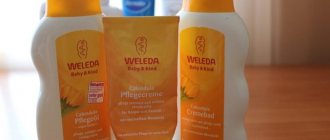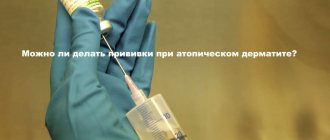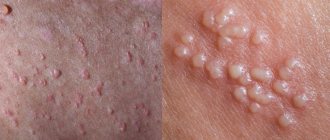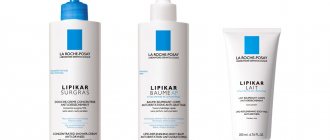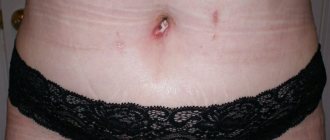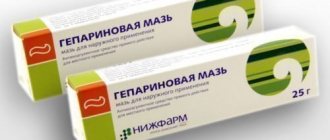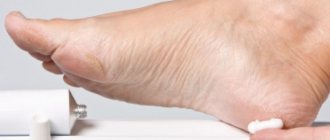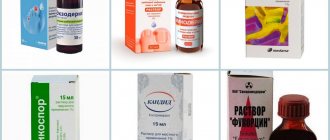Causes and methods of treating dermatitis on the hands
There are plenty of factors that influence the progression of inflammation. Based on the nature of their effects, dermatitis in medicine is classified as one or another type.
External prerequisites for the manifestation of the disease are classified into several categories:
- mechanical damage to the skin;
- influence of UV rays;
- excessively hot or cool weather;
- allergies to plant crops;
- reaction to chemical aggression;
- influence of food components;
- exposure to medications, cosmetics;
- genetic factor;
- weakening of immune function.
The therapeutic process consists of a complex influence and includes the following areas:
- taking systemic medications (doctors prescribe antihistamines that help reduce the intensity of symptoms and eliminate swelling and itching);
- the use of external preparations (a variety of creams, gels, ointments, pastes, aerosols, emulsions are used to reduce external defects and alleviate the condition at the local level);
- the use of folk compositions (more often they are used as auxiliary tactics to facilitate the general well-being of the patient).
Penicillins
Today, quite a few antibiotics are known for skin infections, but the most common for the treatment of dermatological diseases of an infectious nature are penicillins. The most frequently prescribed drugs from this group are penicillin derivatives such as ampicillin, amoxicillin and oxacillin.
The listed antibiotics for the treatment of skin infections have a wide spectrum of action and are able to affect most pathogens. Penicillin drugs have a moderate effect on the kidneys and liver, while promoting the absorption and distribution of substances in the body. The most common drugs in this group are:
- "Amoxiclav". It is a combination drug based on amoxicillin and clavulanic acid as active ingredients. The effect of the drug is prolonged, it does not have a detrimental effect on the functioning of the gastrointestinal tract. The antibiotic is active against enterococci, staphylococci, gonococci and streptococci. The course of taking the drug reaches two weeks. Amoxiclav should not be prescribed for hepatitis, icteric syndrome, infectious mononucleosis, lymphocytic leukemia, or hypersensitivity to penicillins. While taking an antibiotic, it is possible to develop such adverse reactions as dyspepsia, skin allergies, nausea and dizziness. The drug is taken in the morning and evening, one tablet. The dosage is selected individually.
- "Augmentin". Also a broad-spectrum drug from the penicillin group. Has a detrimental effect on microbes, viruses and bacteria. The active components are identical to Amoxiclav. Indications for use, as well as dosage, are also the same for both drugs. Augmentin should not be prescribed to a child under three months of age. In addition to the adverse reactions listed in the previous case, taking an antibiotic can cause colitis and swelling. The drug is also not prescribed during pregnancy and breastfeeding.
What other antibiotics are effective for infections in adults and children?
Classification of ointments for dermatitis on the hands
The range of ointments for dermatitis on the hands is extensive and includes several areas.
- Hormonal agents. They are used in exceptional situations, in the absence of the desired effect from other tested external compositions. Self-therapy is taboo, because medications of this type have many limitations and adverse reactions. They consist of skin atrophy, stretching, and lack of pigmentation. Therapy with these drugs is unacceptable during lactation, pregnancy, or childhood.
- Ointments with non-hormonal influence. The purpose of their practical use is to reduce the inflammatory process and protect the skin of the hands from the influence of adverse environmental factors.
- Antibiotic ointments. They are used in cases of prolonged progression of the disease, when treatment with conventional drugs alone is not enough. Antibacterial external medications are indispensable in the event of an infectious process joining the wounds and the formation of suppuration.
- Combined ointments. Used for therapeutic purposes to eliminate inflammatory reactions. They include several active components at once in order to carry out a comprehensive treatment strategy.
Advantan
Advantan is a medicine that is used to treat atopic dermatitis. Available in the form of emulsion, ointment and cream. The active substance is methylprednisolone aceponate, that is, Advantan is a structural analogue of Comfiderm. The composition also includes paraffin, castor oil, emulsifier, water, glycerol and alcohol. A distinctive feature of Advantan is the availability of the drug for the treatment of atopic dermatitis in young children.
Advantan
Methylprednisolone acetate is the main active ingredient of the cream, which has an anti-inflammatory and moisturizing effect. It belongs to the group of glucocorticosteroids and, with long-term use, can disrupt the release of endogenous steroid hormones by the adrenal glands. In this regard, continuous use of the cream in adults is allowed for 3 months, and in infants from 4 months - no more than 4 weeks.
Indications for use
Specialized topical anti-dermatitis formulations are used in the following cases:
- manifestation of a dermatitis condition of any form and degree;
- addition of a bacterial infection;
- formation of an inflammatory process;
- itching on the affected skin;
- redness of certain areas;
- excessive dryness of the skin;
- pain, burning, discomfort;
- worsening of the general condition caused by the disease;
- prevention of secondary complications.
Ointments for dermatitis
To treat lesions, it is customary to use 4 groups of ointments. The selection of a specific category and name is carried out by a physician. The lists contain the most popular pharmaceutical products for eliminating dermatitis and its symptoms.
External hormonal drugs
- Elokom. The release occurs in the form of lotion, cream, gel. The medication reduces the manifestations of the disease (itching, inflammatory reaction, dryness). Starting price – 180 rub.
- Cutivate. It is famous for its powerful anti-inflammatory effect. Neutralizes the manifestation of itching, hyperemia, burning. The approximate cost starts from 318 rubles.
- Flucinar. Production is established in the form of a gel and ointment. It should be used in case of complicated forms of the disease, accompanied by excessive dry skin. Not used until 2 years. Price – from 180 to 200 rubles.
- Advantan. A fat-based product containing hormonal components. It is used for therapy for dermatitis of any form and origin. Price from 400 rub.
- Afloderm. The fatty base makes the product easily distributed over the skin. The product belongs to the corticosteroid group and eliminates inflammatory processes, fights swelling and itching. The price starts from 400 rub.
Non-hormonal agents
Non-hormonal agents include:
- Fenistil. A progressive gel to combat itching and negative skin reactions to irritants. Has an analgesic effect after insect bites. Costs 250 rubles.
- Dermalex. Regenerates the dermis and maintains optimal moisture levels. The price in Russian pharmacies starts from 400 rubles.
- Bepanten. Forms of production - gels, ointments with the main substance Panthenol. Application: skin healing and prevention of complications. The price is variable and ranges from 150 to 600 rubles.
- Radevit. The ointment is advisable for the progression of chronic dermatitis. Fights inflammation and itching. Costs from 300 to 400 rubles.
- Skin cap. Spray or ointment used for treatment of psoriasis, seborrhea, eczema, dermatitis. Costs from 700 to 1300 rubles, based on the preferred dosage.
- Zinc ointment. A budget-friendly way to get rid of dermatitis. Zinc oxide, the main component, is safe for human health. During application to the skin, a protective barrier is formed, irritation and inflammation are reduced. Costs from 20 rubles.
Antibacterial topical remedies for dermatitis
Antibacterial drugs are presented in several types:
- Levomekol. The drug is recommended by doctors due to its ability to fight swelling and inflammation. The product improves regeneration processes and renews tissue. Instantly heals wounds. It has side effects such as burning, redness, and swelling.
- Syntomycin ointment. Includes the active substance in the form of chloramphenicol, chloramphenicol. Offered for sale in doses of 1%, 5%, 10%. Used in case of suppuration of the skin, the addition of a bacterial process. Not for use by children, pregnant or lactating women.
- Tetracycline. The ointment has been tested against perioral dermatitis. Used as an auxiliary healing tactic. During therapy, it is necessary to refrain from using hand care compositions containing perfumery cosmetic fragrances.
- Gentamicin. The active ingredient of the composition is gentamicin sulfate, used strictly for external purposes. Indicated for treatment in case of progression of infectious and inflammatory processes. Prescribed on the recommendation of the treating specialist in strictly specified dosage regimens. Side effects include nausea, anemia, and kidney failure.
Combined ointments for dermatitis
There are combination remedies for dermatitis.
- Triderm. External cream containing 3 components (active). Fights inflammation and allergies. The hormone Betameson, the antibiotic gentamicin and the anti-fungal element clotrimazole are the composition of the drug. This allows it to be used in the treatment of infected focal lesions.
- Betazon ultra. The composition includes 3 active ingredients. The product is used for therapy for allergic dermatitis with complications. It reduces the degree of inflammation and leads to the neutralization of bacterial infections. It has a high threshold of activity, preferable when other similar compositions are ineffective.
- Triacutan. It is a combination of antibacterial, antipruritic, vasoconstrictor effect. Contains clotrimazole and gentamicin sulfate. It is used in the treatment of indolent dermatous lesions accompanied by the addition of a fungal infectious process.
Features of application
These drugs are usually used according to the classical scheme.
- Hands are cleaned with water and antibacterial soap.
- A medicinal composition is applied to them.
- Leave for a certain time, depending on individual instructions.
- It is washed off or absorbed into the skin.
Tetracyclines
If for some reason it is impossible to prescribe penicillins, they can be replaced by tetracyclines, which also have a detrimental effect on harmful microflora. This group of antibiotics is active against viruses, spirochetes and rickettsia. The most common drugs today are the following:
- "Doxycycline." Shows a high degree of efficiency. The active component is doxycycline hydrochloride. The drug is also prescribed to eliminate infectious lesions of the skin. On the first day of taking Doxycycline, it is taken in the morning and evening, then the dosage is one tablet per day. The course of treatment reaches one week. The antibiotic is contraindicated in case of liver failure, lactose intolerance, hypersensitivity to tetracyclines, under the age of 12 years and against the background of a low level of leukocytes. Undesirable reactions to taking the drug can manifest themselves in the form of nausea, diarrhea, dizziness, allergic reaction and pain in the abdomen.
- "Minocycline." The drug is of semi-synthetic origin. Has an anti-inflammatory effect. The active ingredient is minocycline. The drug is taken one tablet one hour before meals or two hours after, morning and evening. Minocycline should not be prescribed to children under 8 years of age, as well as to pregnant women or if the body is sensitive to the components of the drug. Adverse reactions manifest themselves in the form of dyspepsia, allergies, headaches and dizziness.
Traditional medicine recommendations
Cream, ointment, gel, solution can be made at home.
The following folk recipes allow you to fight the dermatitis agent:
- baths with a decoction of string, chamomile, which have an anti-inflammatory and antibacterial effect;
- juice of cucumber, potato, pumpkin, in which gauze bandages are soaked and then applied to the affected areas;
- homemade ointment with honey is prepared as follows: mix baby cream, golden mustache juice, honey, all this is applied to the skin twice or thrice a day;
- lotions based on cranberry juice, which is mixed in identical quantities with liquid honey (you can add a little propolis);
- Propolis oil is used to treat affected areas throughout the day.
Thanks to the considered compositions, it is possible to achieve an improvement in overall well-being and stabilization of the condition at the local level. In order to choose the optimal medication, as well as regarding the use of traditional recipes, consult your doctor.
Prescribing antibiotics
Preparations for topical use based on antibacterial substances are prescribed for the treatment of dermatological pathologies, the appearance of which is caused by harmful microorganisms. The most common diseases of the dermis are the following infectious lesions:
- Pemphigus in newborns.
- Erysipelas.
- Acrodermatitis atrophying in chronic form.
- Lymphocytoma.
- Impetigo herpetiformis.
- Lupus erythematosus in subacute and acute forms.
- Lichen planus.
- Scleroderma of limited and diffuse type.
- Eczema.
- Furunculosis.
- Injuries exposed to infection.
